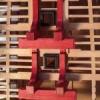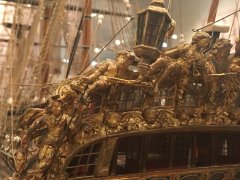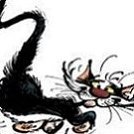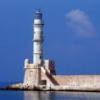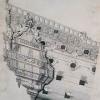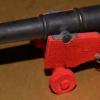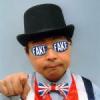MORE HANDBOOKS ARE ON THEIR WAY! We will let you know when they get here.
×
-
Posts
1,644 -
Joined
-
Last visited
Reputation Activity
-
 SJSoane got a reaction from daHeld73 in HMS Bellona 1760 by SJSoane - Scale 1:64 - English 74-gun - as designed
SJSoane got a reaction from daHeld73 in HMS Bellona 1760 by SJSoane - Scale 1:64 - English 74-gun - as designed
HI everyone,
Druxey, remco, EdT, Michael, blue ensign, spencerC, thank you for your kind comments. And many apologies for not replying sooner; work is really getting in the way of the shipyard these days!
After finishing up around the main mast, I sat down one day to finish up the mortises in the beams for carlings. I was inspired by Gaetan, who advised me that doing the same thing over and over, and in a logical order, is efficient, meditative, and it improves one's skills. So I told myself I was not leaving the shop until the remaining mortises were cut. It was hours later, but very satisfying to see all of these after a number of years of looking at the deck without mortises. Gaetan was absolutely right in his advice. i processed each step on all beams, then went back to the first for the next step. It build a great rhythm.
I then turned my attention to the step for the main capstan. You will see in the photo of the original Admiralty drawing that this was very cryptic. How does a circle sit on the beams, and how does one plank up to the circle? I then came across a photo of the Ajax cut away model, showing the entire gun deck. It showed this step as a raised surface in a rectangular plank. After reviewing Steel, I decided that it was really a central, thicker plank, with thinner planks on either side to make up the width across the two central carlings. You can see the dotted line of the three planks in the Admiralty drawing. The projection at the front of the circle is to provide a surface for the pawls, which pivot from the fore edge of the projection and can be kicked under the capstan when wishing to stop rotation either way (another fun part to make some day).
I also remembered from David Antscherl's book that the top surface of the capstan step would have to be parallel to the keel, not parallel to the deck. This is because the capstan turns on an axis perpendicular to the keel, and the aft side would be higher off the deck than the fore side because the deck slopes at this point. Then it made sense that the circle would provide the surface parallel to the keel, and the remainder of the step would be flush with the decking and therefore parallel with the deck, to avoid places to trip when working the capstan. Very ingenious design, when you finally figure out what they were doing.
I had fun with the mill making this. First, you see the step sitting in a vise on the tilting table, having one surface milled down at 1 ½ degrees to match the difference between the deck angle and a line parallel to the keel. Then you see the rotating table, with the step mounted on top. I first used a Starrett wiggler on the central hole of the rotating table to align it with the mill spindle. Then I clamped the step on top, using a Starrett wiggler to locate the center of the step circle also under the mill spindle. I then used a mill cutter to cut a perfect circle around the edge, leaving a flat base with a raised circle at the 1 ½ degree angle. I used chisels to clean up the serpentine curve on either side at the fore end.
I stole the capstan from midships for the photos. I now need to build the second capstan....
Best wishes,
Mark
-
 SJSoane got a reaction from daHeld73 in HMS Bellona 1760 by SJSoane - Scale 1:64 - English 74-gun - as designed
SJSoane got a reaction from daHeld73 in HMS Bellona 1760 by SJSoane - Scale 1:64 - English 74-gun - as designed
Hi everyone,
After building the cisterns, I discovered how difficult it was to locate them square to the mast partners, and the right distance from the mortises for the jeer bitts. So I built a little spacing jig, slotted into the mortises in the partners and with a spacer the right distance to the cistern. Once the cisterns were clamped in place against the jig, I was then able to drill down with a Foredom through the stub pump tube tops, for location pins. I also used this jig to align the hoods so that the future pump handles running through the hoods will line up with the inner face of the bitts where the rhodings will be attached. I made a little sliding joint on the bottom of the hoods so that they could move a little on the cistern athwartships, to allow precise alignment.
And finally, in keeping with the color scheme of the dockyard models that so I admire, I stained the cisterns red, to match the riding bitts. In the closeup, you can see the stump tube tops, and a simplified drain plug. The bearings are still to come. The long shots show how nicely the red accents are showing up along the length of the hull. I know color is not to the taste of everyone, but I like the overall effect of colored accents against the natural wood.
I am being pulled back to work issues, so I may not be able to work and then post for a while. It was a nice run while it lasted....
Best wishes,
Mark
-
 SJSoane got a reaction from daHeld73 in HMS Bellona 1760 by SJSoane - Scale 1:64 - English 74-gun - as designed
SJSoane got a reaction from daHeld73 in HMS Bellona 1760 by SJSoane - Scale 1:64 - English 74-gun - as designed
Hi everyone,
I then started on the pump cisterns. I had originally planned to run the pump tubes down into the hold, but after trying some mock-ups, I reminded myself that my stylized dockland framing system really does start everything above the gun deck for a reason. Without an orlop, a well, or anything else along with the tubes, I decided they would look silly all by themselves down in the hold. So I followed the lead of the HMS Princess Royal in the Legacy of a Model book, and built stub tube tops between the partners and the bottom of the cisterns.
I pondered how to build the coopered covers on the pumps; at 3/16" scale, a ¾" thick shell was too thin to get good coopered joints. So I cheated a little. I turned a wood blank, and then layered the ¾" pieces (plus a little for trimming) on the blank. I then re-chucked this, and turned the assembly down to final size, leaving a clean and accurately sized hood. I cut off the lower half of the blank, leaving the half round hood. They aren't hollow, but I didn't build the pump inside anyway...
Best wishes,
Mark
-
 SJSoane got a reaction from botra288 in HMS Bellona 1760 by SJSoane - Scale 1:64 - English 74-gun - as designed
SJSoane got a reaction from botra288 in HMS Bellona 1760 by SJSoane - Scale 1:64 - English 74-gun - as designed
Hi everyone,
Scary is right. The little birdie on my shoulder was talking to me, and I wasn't quite listening. But you all reminded me. I put much additional safety into the setup by taking my Sherline guard from the lathe and putting it on the mill. Much, much better.
I took a great deal of time today, setting up a spreadsheet of the sizes of everything so they fit the openings of the coamings. I also worked out the menu for dialing in moves on the mill. I have shown an example for the fore hatch, which summarizes dimensions and dialing moves.
I also arranged to screw the wooden block down to the plate on the table. With a little fence on it, it allows me to repeat locations of workpieces so as to make sure I have enough leeway to make the full cuts. The Sherline is very restrictive in the length of cuts set up like this. And the clamps sometimes get in the way. I need to keep working on this idea for the future.
I have also shown the first effort at putting battens in; nothing glued or sanded, obviously. But I am also showing next to it the original grating, which in hindsight I realize had big enough holes in the gratings to trap the captain's heel just as he would have been running to something important. Good thing I caught the mistake....;-)
I have run out of time today, to finish gluing battens, and then to see how sanding away the bottom will reveal the ledges or not. But I do like the self-jigging of this process; last time I really struggled with spacers between ledges moving around while gluing battens. The bottom below the ledges is paper thin and I can see light through it. We'll see tomorrow.
Greg, thanks I knew I had seen the idea of sanding away the bottom somewhere; Clay Feldman!
Mark
-
 SJSoane got a reaction from daHeld73 in HMS Bellona 1760 by SJSoane - Scale 1:64 - English 74-gun - as designed
SJSoane got a reaction from daHeld73 in HMS Bellona 1760 by SJSoane - Scale 1:64 - English 74-gun - as designed
Hi everyone,
Here is the capstan, with lower chocks. Done.
Mark
-
 SJSoane got a reaction from daHeld73 in HMS Bellona 1760 by SJSoane - Scale 1:64 - English 74-gun - as designed
SJSoane got a reaction from daHeld73 in HMS Bellona 1760 by SJSoane - Scale 1:64 - English 74-gun - as designed
Like Remco reported the other day, I temporarily ran out of energy for the ship. I moved to a larger scale project, and finally built a shooting board for planing exact right angled and straight cuts on the edges of small boards.
I found a great design online, which I modified to suit my needs. You can see the original article at:
http://www.highlandwoodworking.com/woodnews/2010july/shootingboards.html
This is a great design. It runs the plane along a sloping surface, so that the entire width of the plane is used to even out wear. It also provides a shearing cut, which helps with hard wood like boxwood.
A shooting board works on the very clever idea that the plane blade in a normal plane does not go all the way to the side of the plane. So when it is run along the fence of the shooting board, the blade cuts into most of the fence, but not the little edge where the blades stops short of the side. This little edge provides a constant surface for guiding the plane.
I still have to attach a fence, but that will have to wait for more time in the shop.
With a good fence at exactly 90 degrees and a very sharp plane, I could trim the ends of slightly too long carlings, rather than using the disk sander. I'll see how it works.
That is a Lie Nielsen plane designed to use with shooting boards. A gem to use.
Mark
-
 SJSoane got a reaction from druxey in HMS Bellona 1760 by SJSoane - Scale 1:64 - English 74-gun - as designed
SJSoane got a reaction from druxey in HMS Bellona 1760 by SJSoane - Scale 1:64 - English 74-gun - as designed
Hi everyone,
I got a little further on cutting the birdsmouth rabbets on the whelps for the chocks. Using the little holding jig really helped. I was able to use the scoring marking gauge to keep the joints at the same height, and then a free-handed chisel cut for the birdmouth. By the way, I spot glued the whelps into the jig to hold them in place, then soaked them off with isopropyl alcohol 99%. The spots of glue were really tiny, but they held.
Best wishes,
Mark
-
 SJSoane got a reaction from daHeld73 in HMS Bellona 1760 by SJSoane - Scale 1:64 - English 74-gun - as designed
SJSoane got a reaction from daHeld73 in HMS Bellona 1760 by SJSoane - Scale 1:64 - English 74-gun - as designed
Thank you Michael, Bob and Toni. Your comments help keep me going.
I was feeling less skilled this weekend, still struggling with the whelps and chocks on the capstan. After trying several ways to cut the rabbets for the chocks, without success, I had another idea that I will try this afternoon.
But while I was pondering this, I took some time to clear my head by moving from little to large. I re-leveled the top of my workbench (I haven't done that since I built it 20 years ago), using a hand plane. Very satisfying physical work after so much close precision. Lefties will note that I built this bench backwards, with the shoulder vise at the right end, since I am also left-handed.
Back to whelps and chocks....
Mark
-
 SJSoane got a reaction from Alan Cabrera in HMS Bellona 1760 by SJSoane - Scale 1:64 - English 74-gun - as designed
SJSoane got a reaction from Alan Cabrera in HMS Bellona 1760 by SJSoane - Scale 1:64 - English 74-gun - as designed
Thank you Colin, my skills have definitely improved as I get further into the project. Gaetan gave me great advice, which is to think of potentially boring tasks like cutting hundreds of mortises for the deck carlings and ledges as a way of honing skills. It makes the time pass more tolerably, and skills definitely increase!
I still return to mechanical devices like mills and custom jigs to control cuts where precision is important and I don't trust my hand, but I am slowly learning more hand skills with chisels and planes. It is all part of the fun of the project.
One of these days, I might try writing down what I have learned about craftsmanship so far through this project, from some great tutors on this site.
Mark
-
 SJSoane got a reaction from botra288 in HMS Bellona 1760 by SJSoane - Scale 1:64 - English 74-gun - as designed
SJSoane got a reaction from botra288 in HMS Bellona 1760 by SJSoane - Scale 1:64 - English 74-gun - as designed
Daniel,
Many apologies, I forgot to post the picture of the measuring device on the board with the drawing. Here it is:
Mark
-
 SJSoane got a reaction from botra288 in HMS Bellona 1760 by SJSoane - Scale 1:64 - English 74-gun - as designed
SJSoane got a reaction from botra288 in HMS Bellona 1760 by SJSoane - Scale 1:64 - English 74-gun - as designed
Thank you, druxey, Christian and Ed. All of this re-posting is allowing us to see all of the builds afresh! Ed, I will be particularly happy when we have your index again. I used that fairly regularly.
Daniel, the blue track idea comes from Ed, and it is made from components purchased at Rockler Woodworking. All of the parts for the track and the tightening bolts and knobs are already made. The link to the site is:
http://woodworking.rockler.com/c/jigs-jig-its-t-tracks
I recall that I used a router with a bit exactly the width of the track, using a fence on the router to keep it parallel to the sides of the building board. Once the grooves are cut, the tracks are very easy to screw in.
The bridge was a little trickier, because it wants to be exactly right angles to the building board, and have some way of lining up with the station lines of the plan on the board. Ed developed one idea, and I tried a slight variation that I showed in the previous pictures. Ed, are you able yet in your re-posting to link to your bridge design? I recall Ed has an way of fixing his camera to the bridge, which I want to try someday.
The final complexity was to get the top of the bridge to the building board surface to be exactly the same distance as the top of my board with the section drawing pasted on, to the bottom of the keel. That is so measurements taken off the board with the drawing will exactly match the same height on the actual model measured from the bridge. I hope the photos explain this well. If not, I'll do a little drawing of the arrangement.
Best wishes,
Mark
-
 SJSoane got a reaction from daHeld73 in HMS Bellona 1760 by SJSoane - Scale 1:64 - English 74-gun - as designed
SJSoane got a reaction from daHeld73 in HMS Bellona 1760 by SJSoane - Scale 1:64 - English 74-gun - as designed
almost up to date...
-
 SJSoane got a reaction from Alan Cabrera in HMS Bellona 1760 by SJSoane - Scale 1:64 - English 74-gun - as designed
SJSoane got a reaction from Alan Cabrera in HMS Bellona 1760 by SJSoane - Scale 1:64 - English 74-gun - as designed
Hi everyone,
And here are the drawings I created from the Admiralty draughts of HMS Dragon, The Bellona's sister ship (the NMM could not find the Bellona drawings when I ordered these back in the 1990s; I don't know if they ever turned up).
The xerox copies showed that the original 250 year old drawings were quite distorted and therefore not able to be built from. Also I did not know how I would ever fit a 1/4" scale model of a 74 in my house. So I drew these at 3/16", or 1:64. The Admiralty drawings were very schematic, and so I had to develop all of the details from other standard sources.
Mark
-
 SJSoane got a reaction from Obormotov in HMS Victory by guraus - scale 1:48 - plank on frame
SJSoane got a reaction from Obormotov in HMS Victory by guraus - scale 1:48 - plank on frame
Hi Alexandru, it is great to look through the first stages of your project again!
Mark
-
 SJSoane got a reaction from druxey in HMS Bellerophon 1786 by AON – scale 1:64 – 74-gun 3rd Rate Man of War - Arrogant-Class
SJSoane got a reaction from druxey in HMS Bellerophon 1786 by AON – scale 1:64 – 74-gun 3rd Rate Man of War - Arrogant-Class
Hi Alan,
You might have a look at some conversations about this problem at my Bellona website.
In posting #173 (about page 6) and onward, is a discussion about the stern roundups. I found out years later in Steel's Naval Architecture that the roundups of the beams at the stern of the upper deck and quarterdeck are indeed intentionally higher than the standard beams further forward on each of these decks, for the aesthetic reason druxey described. These are faired in smoothly so the deck does not have a bump in it at any place; but it means that every beam from the stern to the point of fairing into the standard beams is a slightly different roundup. Sneaky! I kind of faked mine, making beams a little larger and then smoothing down the upper deck surface. I didn't understand why at the time, but got there in the end. I think....
In posting #198 and onward, I show a jig I made to manage all of the roundups and arrangements of the vertical stern timbers, to keep everything in place and symmetrical. A lot of work to make the jig, but then everything fell into place very quickly.
Hope this helps!
Mark
-
 SJSoane got a reaction from Mike Y in HMS Bellona 1760 by SJSoane - Scale 1:64 - English 74-gun - as designed
SJSoane got a reaction from Mike Y in HMS Bellona 1760 by SJSoane - Scale 1:64 - English 74-gun - as designed
I have now drilled the hawse holes, and fitted a bolster waiting for final assembly for final trimming:
I now have to turn my attention to the trailboard. I am getting closer to painting the blue around this area, and I want to know where the trailboards need gluing.
I want to build the Bellona as first designed, and shown in the first model. But the trailboard detail is frustratingly difficult to see or to reconstruct, from the photo I took:
Unless someone has a better photo, I may have to build the trailboard on the second Bellona model:
If I do the latter, do you have any advice for how to glue this down to a backing board for piercing and carving, and then how to get it unglued from the backing board with those tiny, fragile pieces holding it together?
Mark
-
 SJSoane got a reaction from Mike Y in HMS Bellona 1760 by SJSoane - Scale 1:64 - English 74-gun - as designed
SJSoane got a reaction from Mike Y in HMS Bellona 1760 by SJSoane - Scale 1:64 - English 74-gun - as designed
Thanks so much for the kind comments, Yancovitch and Steve. Slow but steady!
In my last post, I express doubts about the way I had managed the hair bracket, sitting tenuously on top of the knee at the stem. After pondering it a while, I decided there was nothing for it but to cut down the top of the knee that I had shaped in 1998 when I started construction (see image below). It was too short for the hair bracket, the gammoning slot and the hole for the mainmast stay collar were in the wrong locations. To this day, I don't quite know how I got that so wrong. I might have copied something out of Lavery's book on the Bellona, which I have subsequently discovered is not accurate enough to build a model from. And I started construction years before I finally started drawing more accurate drawings--always a mistake!
So, I made a complete new piece, combining the hair bracket and a carved ornamental piece that stands directly behind the figurehead. It seemed more solid the two together, and they are the same thickness relative to the figure head:
And after a lot of faying and tapering, the new core for the hair brackets now holds everything firmly together.
I made up a dummy of Bellona (don't tell her I said that, she is supposed to be a very scary warrior...), just to see how things are starting to fit together. The first image below shows the new core piece still covered in the paper pattern, showing the bas-relief carving to come on the piece behind the figurehead (she is pulled away from it a little in this photo). It also shows the captain standing on the cheeks. Gives a good idea of the size of the figurehead.
And here are parts starting to fall into place:
I have been reading David Antscherl's excellent explanation of how to carve a figure head in Volume II of the Fully Framed Model. I might start with the maquette, and see how it goes...
I have pondered what wood to use, to carve the figures on the ship. My boxwood is not buxus semperivens, the stuff the old modeler's used, and that David recommended when he first wrote his book. But I can find no supplier anywhere in the world of buxus semperivens anymore. I know my boxwood is from South America, but I don't know its actual species. It seems to be stiffer in relation to what others have written about working true boxwood. I think it will have to do. And I can always blame a bad outcome on bad tools or bad wood, not lack of skill!🙂
Best wishes,
Mark
edited with higher resolution image here:
-
 SJSoane got a reaction from Heinrich der Seefahrer in HMS Bellona 1760 by SJSoane - Scale 1:64 - English 74-gun - as designed
SJSoane got a reaction from Heinrich der Seefahrer in HMS Bellona 1760 by SJSoane - Scale 1:64 - English 74-gun - as designed
I have now drilled the hawse holes, and fitted a bolster waiting for final assembly for final trimming:
I now have to turn my attention to the trailboard. I am getting closer to painting the blue around this area, and I want to know where the trailboards need gluing.
I want to build the Bellona as first designed, and shown in the first model. But the trailboard detail is frustratingly difficult to see or to reconstruct, from the photo I took:
Unless someone has a better photo, I may have to build the trailboard on the second Bellona model:
If I do the latter, do you have any advice for how to glue this down to a backing board for piercing and carving, and then how to get it unglued from the backing board with those tiny, fragile pieces holding it together?
Mark
-
 SJSoane got a reaction from GrandpaPhil in HMS Bellona 1760 by SJSoane - Scale 1:64 - English 74-gun - as designed
SJSoane got a reaction from GrandpaPhil in HMS Bellona 1760 by SJSoane - Scale 1:64 - English 74-gun - as designed
I have now drilled the hawse holes, and fitted a bolster waiting for final assembly for final trimming:
I now have to turn my attention to the trailboard. I am getting closer to painting the blue around this area, and I want to know where the trailboards need gluing.
I want to build the Bellona as first designed, and shown in the first model. But the trailboard detail is frustratingly difficult to see or to reconstruct, from the photo I took:
Unless someone has a better photo, I may have to build the trailboard on the second Bellona model:
If I do the latter, do you have any advice for how to glue this down to a backing board for piercing and carving, and then how to get it unglued from the backing board with those tiny, fragile pieces holding it together?
Mark
-
 SJSoane got a reaction from druxey in HMS Bellona 1760 by SJSoane - Scale 1:64 - English 74-gun - as designed
SJSoane got a reaction from druxey in HMS Bellona 1760 by SJSoane - Scale 1:64 - English 74-gun - as designed
I have now drilled the hawse holes, and fitted a bolster waiting for final assembly for final trimming:
I now have to turn my attention to the trailboard. I am getting closer to painting the blue around this area, and I want to know where the trailboards need gluing.
I want to build the Bellona as first designed, and shown in the first model. But the trailboard detail is frustratingly difficult to see or to reconstruct, from the photo I took:
Unless someone has a better photo, I may have to build the trailboard on the second Bellona model:
If I do the latter, do you have any advice for how to glue this down to a backing board for piercing and carving, and then how to get it unglued from the backing board with those tiny, fragile pieces holding it together?
Mark
-
 SJSoane got a reaction from KARAVOKIRIS in HMS Bellona 1760 by SJSoane - Scale 1:64 - English 74-gun - as designed
SJSoane got a reaction from KARAVOKIRIS in HMS Bellona 1760 by SJSoane - Scale 1:64 - English 74-gun - as designed
I have now drilled the hawse holes, and fitted a bolster waiting for final assembly for final trimming:
I now have to turn my attention to the trailboard. I am getting closer to painting the blue around this area, and I want to know where the trailboards need gluing.
I want to build the Bellona as first designed, and shown in the first model. But the trailboard detail is frustratingly difficult to see or to reconstruct, from the photo I took:
Unless someone has a better photo, I may have to build the trailboard on the second Bellona model:
If I do the latter, do you have any advice for how to glue this down to a backing board for piercing and carving, and then how to get it unglued from the backing board with those tiny, fragile pieces holding it together?
Mark
-
 SJSoane got a reaction from Hubac's Historian in HMS Bellona 1760 by SJSoane - Scale 1:64 - English 74-gun - as designed
SJSoane got a reaction from Hubac's Historian in HMS Bellona 1760 by SJSoane - Scale 1:64 - English 74-gun - as designed
I have now drilled the hawse holes, and fitted a bolster waiting for final assembly for final trimming:
I now have to turn my attention to the trailboard. I am getting closer to painting the blue around this area, and I want to know where the trailboards need gluing.
I want to build the Bellona as first designed, and shown in the first model. But the trailboard detail is frustratingly difficult to see or to reconstruct, from the photo I took:
Unless someone has a better photo, I may have to build the trailboard on the second Bellona model:
If I do the latter, do you have any advice for how to glue this down to a backing board for piercing and carving, and then how to get it unglued from the backing board with those tiny, fragile pieces holding it together?
Mark
-
 SJSoane got a reaction from mtaylor in HMS Bellona 1760 by SJSoane - Scale 1:64 - English 74-gun - as designed
SJSoane got a reaction from mtaylor in HMS Bellona 1760 by SJSoane - Scale 1:64 - English 74-gun - as designed
Hi Alan,
I like the idea of letting it release without having to pry two things apart. I'll try the PVA and alcohol idea.
Mark
-
 SJSoane got a reaction from Mark P in HMS Bellona 1760 by SJSoane - Scale 1:64 - English 74-gun - as designed
SJSoane got a reaction from Mark P in HMS Bellona 1760 by SJSoane - Scale 1:64 - English 74-gun - as designed
I have now drilled the hawse holes, and fitted a bolster waiting for final assembly for final trimming:
I now have to turn my attention to the trailboard. I am getting closer to painting the blue around this area, and I want to know where the trailboards need gluing.
I want to build the Bellona as first designed, and shown in the first model. But the trailboard detail is frustratingly difficult to see or to reconstruct, from the photo I took:
Unless someone has a better photo, I may have to build the trailboard on the second Bellona model:
If I do the latter, do you have any advice for how to glue this down to a backing board for piercing and carving, and then how to get it unglued from the backing board with those tiny, fragile pieces holding it together?
Mark
-
 SJSoane got a reaction from fake johnbull in HMS Bellona 1760 by SJSoane - Scale 1:64 - English 74-gun - as designed
SJSoane got a reaction from fake johnbull in HMS Bellona 1760 by SJSoane - Scale 1:64 - English 74-gun - as designed
I have now drilled the hawse holes, and fitted a bolster waiting for final assembly for final trimming:
I now have to turn my attention to the trailboard. I am getting closer to painting the blue around this area, and I want to know where the trailboards need gluing.
I want to build the Bellona as first designed, and shown in the first model. But the trailboard detail is frustratingly difficult to see or to reconstruct, from the photo I took:
Unless someone has a better photo, I may have to build the trailboard on the second Bellona model:
If I do the latter, do you have any advice for how to glue this down to a backing board for piercing and carving, and then how to get it unglued from the backing board with those tiny, fragile pieces holding it together?
Mark


